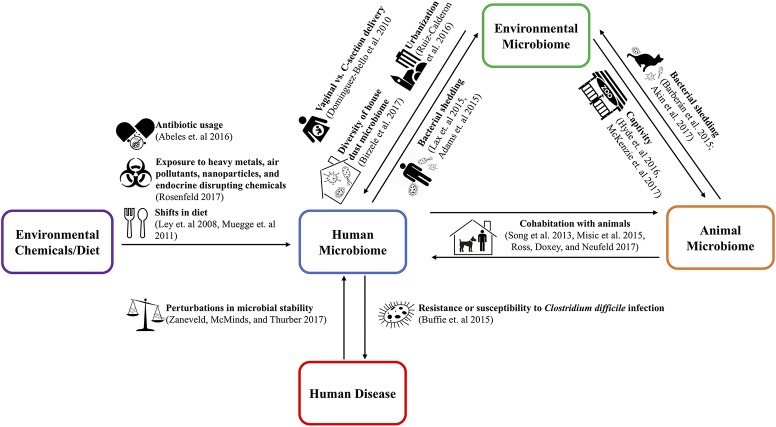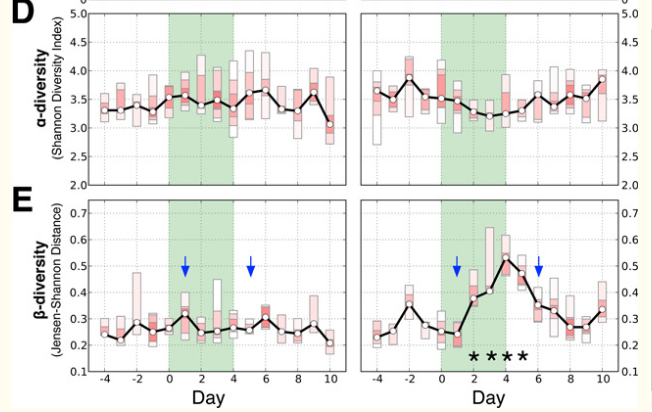Microbiome
Microbes lives with us in symbiosis, but if they multiply, they can cause different problems. Should you pay close attention to microbiome or is it overhyped?
In the article you will learn:
- What is microbiome and it’s role in human health
- How to eat for healthy gut microbiome
- Microbiome testing, gut health, allergies and food intolerances
- Microbiome and sports performance
- The best practices to support healthy gut
What is microbiome?
When we hear the word bacteria, we usually have a negative association with it. They are disease caring, invisible, and all around us. Fortunatelly, most bacteria are not harmful, and many of them are our closest friends. Nearly all living organisms, both animals and plants are associated with microbes that play important roles in their physiology.
The microbes associated with our bodies are pretty much everywhere: on our skin, between our teeth, in our saliva and stomachs, but the largest group of them is housed inside our large intestine. Together we call all these bacteria species micrbiom or microbiota.
Interesting facts about microbiome:
-
Some sources cite our bodies contain 100 trillion of them. Microbes outnumber our human cells ten to one.
-
The bacteria in the microbiome help digest our food, regulate our immune system, protect against other bacteria that cause disease, and produce vitamins including B vitamins like B12, thiamine and riboflavin, and Vitamin K, which is needed for blood coagulation.
-
The microbiome was not generally recognized to exist until the late 1990s
-
Microbiome is passed down from mother to child during birth, except for the C-section, which is done in sterile environment.
-
Early and middle childhood may represent a crucial window when the gut microbiome is developed and changeable through diet.
Healthy intestinal microflora has received a lot of attention in recent years. So how would we define it?
We cannot clearly define an ideal or healthy intestinal microflora. Terms such as dysbiosis and “unhealthy bowel” are often used to sell a cure for a problem that is elsewhere.
Some of the observed changes in the microbiome are specific to certain diseases and disorders of the digestive tract affect digestion and our ability to absorb nutrients. This can lead to indigestion.
At present, however, information is being collected on the microbiome of various populations, but we cannot define exactly what “healthy mircobiome” looks like. When we do not know how to define a healthy microbiome (specific strains bacteria and their ratios), we cannot subsequently prescribe how to get to it.
However, we know that a diverse microbiome is good for health and that it is one of the parts of a healthy gut. Therefore, there is no need to focus exclusively on the microbiome.
Microbial Diversity
There are two terms important in microbial diversity:
Alpha-diversity – a characteristic of a single population, usually involving measurements of the number of different species and the distribution of observed species.
Beta-diversity – a characteristic of several populations, usually including the numbers of one population relative to another.
When analyzing and interpreting the microbiome, it is necessary to look at the measurements of both diversities to obtain an overall picture.
For example, a change in diet and lifestyle may increase the number of species and the total number of microbes in one population, but we might not see a difference or know the cause compared to another population.
What affects the microbiome?
Bacteria are found all around us and in us. Factors such as disinfection, antibiotic use, environment, stress, lifestyle (diet and exercise) and, last but not least, genetics affect the composition of our microbiome.
Excessive use of antibiotics and insufficient exposure to microorganisms found in nature and around us from animals, plants and soil are problematic. Exposing yourself to microbes strenghtens your immune systems. (Trinh P, 2019).
Large-scale animal husbandry is closely linked to the spread and emergence of disease. Therefore, antibiotics have been widely used in this industry in the past, which has contributed to the development of drug-immune bacteria. In 2019, the EU issued directives banning the preventive use of antibiotics for animals.
Animal products are controlled for antibiotic content and cannot legally go on sale if they exceed the limit set by regulations. Whether or not they get into market is questionable. Therefore, if you can, I recommend avoiding animal products from large farms. They are not healthy nor ecological.
“It is illegal to use medically important antibiotics for production purposes, and animal producers now need to obtain authorization from a licensed veterinarian to use them for treatment, prevention, and control of a specifically identified disease.” – Centers for Disease Control and Prevention

Can diet affect the diversity of the microbome?
Diet affects the composition of the microbiome, because the food we eat also feeds our microbes. In a study from 2014 (David, L, 2019) the authors clearly demonstrated how diet affects the composition of the microbiome in just a few days.
Specifically, they compared changes in a diet based on plant foods and animal foods (meat and cheese).
When participants ate a plant-based diet, their average fiber intake changed from 9 g / day to 26 g / day! In the case of the animal diet, fiber intake decreased to 0 g / day because meat and cheese do not contain fiber.
Initially, participants consumed about 35% of their calories from fat, which dropped to about 22% on a plant-based diet, but almost doubled to 70% on an animal diet.
Protein intake also almost doubled, from 16% at the start of treatment to 30% on an animal-based diet; decreased to 10% in plant diets.

This does not mean that their microbiomes were more diverse / healthier in the animal diet! This simply means that they were very different from the initial value, because microbes that require carbohydrates in the diet died while others multiplied.
In this study, they observed how the number of certain species of bacteria on the animal’s diet was associated with the development of inflammatory bowel disease. These bacteria are typical of diets high in fat and saturated fat.
Diet alters the composition of the microbiome in just a few days.
A plant-based diet that is rich in fiber and higher in carbohydrates (about 50% or more) is beneficial for microbiome diversity and overall health.
Does microbiome affect the energy balance?
In healthy adults, ~ 85% of carbohydrates, 65–95% of proteins, and nearly all fats are absorbed before entering the large intestine.
Indigestible carbohydrates and proteins that enter the colon represent between 10 and 30% of total ingested energy. Without the colonic microbiota, these nutrients would generally be eliminated via the stool. The gut microbiota can be influenced by the composition of the diet and the amount of energy entering this environment. (Mohr, AE., 2020)
Our microbes can synthesize fatty acids and vitamins for us. But current evidence indicates that the overall effect on our energy intake is relatively small, and doesn’t occur at all in some people. 5-15% (or up to 200kcal) seems to be possible, but we cannot measure this precisely.
In a controlled study (Corbin, K.D., 2023), they found that the Traditional Western Diet resulted in a 116+-65kcal/day higher energy absorption than the microbiome-optimized diet. They did not notice changes in the feeling of hunger and satiety.
These differences are unlikely to stall weight loss.
It has been observed that obese humans have less bacterial species in their stool than lean people. (Zuo HJ, 2011) Higher diversity of microbiota composition was associated with lean phenotypes compared to that of obese individuals. (Mohr, AE., 2020) That lead some researchers to believe that altering microbiome through fecal transplants could be used in threating obesity by altering microbiome. Although such transplants result in a change in the microbiome, the change is only temporary, and the effect is more pronounced in insulin sensitivity.
However, current studies cannot conclude that alterations of the microbiome would result in weight change. Rather, studies constantly point to a healthy lifestyle including varied diets and physical activity as reliable ways to lose weight. (Xiao H and Kang S, 2020)
The microbiome and diet are closely related. A diet based on vegetables, fruits, legumes, grains, and fermented foods nourishes healthy bacteria while leading to lower energy intake.
How to support a healthy microbiome with diet?
The short answer is to eat at least 30 different plants a week.
Microbially available carbohydrates in the form of fermentable fibers can be found in various fruits, vegetables, whole grains, nuts, seeds and legumes.
Omega-3 and omega-6 fatty acids can be found in nuts, seeds and fatty fish.
Whether you choose to eat animal or vegetable protein does not affect the composition and diversity of the microbiome if you eat enough fiber!
The diet associated with the varied microbiome is a Mediterranean strain that is based on plant foods, but also includes animal foods such as fish, eggs, cheese and even wine.
Are prebiotics as effective as real food?
Simply put, if you spend the same amount of money on different real foods (containing different types of fiber) and prebiotic supplements (contianing one type of fiber), you will benefit much more from food.
Whole foods contain several types of fiber and other vitamins and minerals.
Microbiome testing, allergies, intolerances
What is food sensitivity and can you believe the tests?
The term people use to define food intolerance is usually food sensitivity, measured by IgG response. It is an antibody recognition system. which simply tells us you have ingested that food before and your body’s immune system recognizes the antibody. It does not mean you have a negative reaction to it.
The Canadian Society of Allergy and Clinical Immunology concluded in 2012 and concluded that there was no research supporting the use of these tests to diagnose or predict food side effects. (Carr S, 2012) These same conclusions were supported by the American Academy of Allergies and Asthma (Stapel SO, 2008) or a recent review study published in the CMAJ. Even IgE tests used to test for food allergies show a high percentage of false positives. ()
Can the comprehensive stool analysis (CSA) predict your perfect diet?
In this newest iteration of gene-based dietary recommendations (circa the 2010’s), manufacturers sell kits that function similarly to CSA’s, identifying microbes and sometimes gene pathways. They then make recommendations about which foods would be ‘ideal’ for your specific microbiome.
Long-term dietary habits are associated with certain taxa (groups of microbes) as well as markers of inflammation and gene activity. Because different microbes have different functions governed by different genes, we would expect to see a wide variety and some influence of the diet that contains compounds they might metabolize in some way.
These tests are a snapshot of your current microbial ecosystem, which has been influenced by tons of factors, including your recent diet. Your microbes aren’t asking for what they need. They’re telling you what they’ve been getting.
Microbiome in exercise and sports performance
The gut microbiome is not well studied yet and microbiome’s role in sports performance is even less understood.
From the preliminary research, it appears that athletes have different microbiome compared to less active or sedentary people. This might be caused by activity and also by different diets athletes adhere to.
Since strong and healthy gut is important for general health, it is also important for sports performance. Even if it does not hve direct performance enhancing (ergogenic) effects, staying healthy and able to train is essential for athletic development.
Based on the current body of research, exercise appears to enrich microbiota diversity and alter the it’s composition, improve barrier functions, and stimulate bacteria and functional pathways capable of producing substances that protect against gastrointestinal disorders and improve performance.(Mohr, AE. 2020).
Best practices to promote healthy gut and conclussions
Microbiome plays an important role in health, disease prevention, digestion. It appears that in future, practices like microbiome transplantations could be used to improve health and treat specific disease. But before we make an effective interventions, first we need to understand specific roles of different microbes better.
Focusing on healthy practices like eating predominantly plant based diet rich in fiber, exercising regularly, avoiding antibiotics overuse, alcohol, smoking, and managing stress are general health practices that also impact microbiome. Therefore we should not be trying to alter microbiome directly by transplantations and rather focus on these healthy practices.
The three main drivers of microbial diversity are:
- Eat a variety of plant foods, ideally at each meal.
- Engage in regular physical activity trying to meet the general recommendations of 30 minutes per day.
- Bias diet more towards higher carbohydrate intake, rather than higher
Learn how to best fuel your body
If you want to learn how to best fuel your body, stop tracking your food and meet with Daniel who specializes in sports nutrition and can help you create a sustainable diet/food plan that fits your unique needs and lifestyle.
- Click the link below
- Fill-in the intake form
- Wait for my email to schedule a strategy call. I reply within 24 hours.
Looking forward to hear from you,
Daniel
References
- David, L., Maurice, C., Carmody, R. et al. Diet rapidly and reproducibly alters the human gut microbiome. Nature 505, 559–563 (2014). https://doi.org/10.1038/nature12820
- Xiao H and Kang S (2020) The Role of the Gut Microbiome in Energy Balance With a Focus on the Gut-Adipose Tissue Axis. Front. Genet. 11:297. doi: 10.3389/fgene.2020.00297
- Carr S, Chan E, Lavine E, Moote W. CSACI Position statement on the testing of food-specific IgG. Allergy Asthma Clin Immunol. 2012;8(1):12. Published 2012 Jul 26. doi:10.1186/1710-1492-8-12
- Stapel SO, Asero R, Ballmer-Weber BK, et al. Testing for IgG4 against foods is not recommended as a diagnostic tool: EAACI Task Force Report. Allergy. 2008;63(7):793-796. doi:10.1111/j.1398-9995.2008.01705.x
- Diagnosis and management of food allergy,
- Elissa M. Abrams and Scott H. Sicherer, CMAJ October 18, 2016 188 (15) 1087-1093; DOI: https://doi.org/10.1503/cmaj.160124
- REGULATION (EU) 2019/6 OF THE EUROPEAN PARLIAMENT AND OF THE COUNCIL. EUR-Lex. (2019, January 7). https://eur-lex.europa.eu/legal-content/EN/AUTO/?uri=celex%3A32019R0006.
- Trinh P, Zaneveld JR, Safranek S, Rabinowitz PM. One Health Relationships Between Human, Animal, and Environmental Microbiomes: A Mini-Review. Front Public Health. 2018;6:235. Published 2018 Aug 30. doi:10.3389/fpubh.2018.00235
- Centers for Disease Control and Prevention. (2021, March 15). Food and Food Animals. Centers for Disease Control and Prevention. https://www.cdc.gov/drugresistance/food.html.
- Mohr, A.E., Jäger, R., Carpenter, K.C. et al. The athletic gut microbiota. J Int Soc Sports Nutr 17, 24 (2020). https://doi.org/10.1186/s12970-020-00353-w
- Corbin, K.D., Carnero, E.A., Dirks, B. et al. Host-diet-gut microbiome interactions influence human energy balance: a randomized clinical trial. Nat Commun 14, 3161 (2023). https://doi.org/10.1038/s41467-023-38778-x
